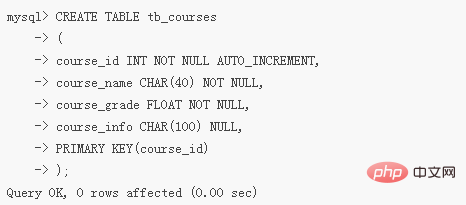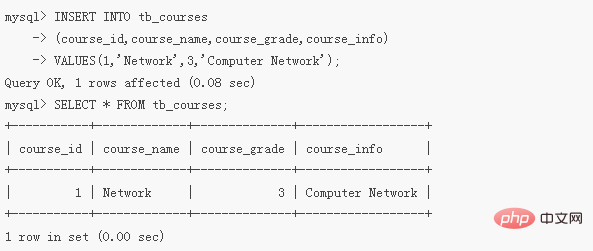 Common Problem
Common Problem
 Can the create statement be used to create a table structure and append new records?
Can the create statement be used to create a table structure and append new records?
Can the create statement be used to create a table structure and append new records?
cannot. The function of the CREATE statement is to create a table structure, but it cannot append new records. You can use the INSERT statement to append new records. The CREATE statement can be used to create a new table in the database and specify the attributes and constraints of the data columns; however, the newly created table is an empty table and requires the use of the INSERT statement to append new records. The INSERT statement is used to insert one or more rows of tuple data into an existing table in the database.

The operating environment of this tutorial: windows7 system, mysql8, Dell G3 computer.
"The create statement is used to create a table structure and append new records" is wrong.
The function of the CREATE statement is to create a table structure, but it cannot append new records. You can use the INSERT statement to append new records.
CREATE statement
The CREATE statement can be used to create a new table in the database; the process of creating a data table specifies the attributes of the data columns The process is also the process of enforcing data integrity (including entity integrity, referential integrity and domain integrity) constraints.
The syntax format for creating a table is:
CREATE TABLE <表名> ([表定义选项])[表选项][分区选项];
Among them, the format of [Table definition option] is:
<列名1> <类型1> [,…] <列名n> <类型n>
CREATE TABLE command syntax is more, among which It is mainly composed of table creation definition (create-definition), table options (table-options) and partition options (partition-options).
Here we first describe a simple example of creating a new table, and then focus on some main syntax knowledge points in the CREATE TABLE command.
The main syntax and usage instructions of the CREATE TABLE statement are as follows:
CREATE TABLE: used to create a table with a given name, you must have table CREATE permissions.
: Specifies the name of the table to be created, given after CREATE TABLE, and must comply with the identifier naming rules. The table name is specified as db_name.tbl_name to create the table in a specific database. It can be created this way regardless of whether there is a current database. db-name can be omitted when creating a table in the current database. If you use quoted distinguished names, the database and table names should be quoted separately. For example, 'mydb'.'mytbl' is legal, but 'mydb.mytbl' is not.
: Table creation definition, consisting of column name (col_name), column definition (column_definition), and possible null value specifications, integrity constraints, or table indexes composition.
By default, the table is created in the current database. If the table already exists, there is no current database, or the database does not exist, an error will occur.
Example: Create tb_courses data table
CREATE TABLE tb_courses( course_id INT NOT NULL AUTO_INCREMENT, course_name CHAR(40) NOT NULL, course_grade FLOAT NOT NULL, course_info CHAR(100) NULL, PRIMARY KEY(course_id) );
Copy after login
Check the data of tb_emp1 data table
SELECT * FROM tb_courses;
Copy after login
You can see that the newly created table does not contain data. Inserting records requires the use of the INSERT statement.
INSERT statement
The INSERT statement can insert one or more rows of tuple data into an existing table in the database.
The INSERT statement has two syntax forms, namely the INSERT…VALUES statement and the INSERT…SET statement.
1) INSERT…VALUES statement
INSERT VALUES 的语法格式为: INSERT INTO <表名> [ <列名1> [ , … <列名n>] ] VALUES (值1) [… , (值n) ];
Copy after loginThe syntax is explained as follows.
: Specify the name of the table to be operated on.
: Specify the column name into which data needs to be inserted. If data is inserted into all columns in the table, all column names can be omitted, and INSERT VALUES(…) can be used directly.
VALUES or VALUE clause: This clause contains the list of data to be inserted. The order of data in the data list should correspond to the order of columns.
2) INSERT...SET statement
The syntax format is:
INSERT INTO <表名> SET <列名1> = <值1>, <列名2> = <值2>, …Copy after loginThis statement is used to directly add data to the table. Certain columns specify corresponding column values, that is, the column name of the data to be inserted is specified in the SET clause, col_name is the specified column name, and the equal sign is followed by the specified data. For unspecified columns, the column value will be specified. The default value for this column.
In MySQL, processing multiple inserts with a single INSERT statement is faster than using multiple INSERT statements. When using a single INSERT statement to insert multiple rows of data, you only need to enclose each row of data in parentheses.
Example: Add values to all fields in the table
Insert a new record in the tb_courses table, course_id value is 1, course_name value is "Network", course_grade The value is 3 and the info value is "Computer Network".
INSERT INTO tb_courses (course_id,course_name,course_grade,course_info) VALUES(1,'Network',3,'Computer Network');
Copy after login
#You can see that the record was inserted successfully. When inserting data, all fields of the tb_courses table are specified, so new values will be inserted for each field.
【Related recommendations: mysql video tutorial】
The above is the detailed content of Can the create statement be used to create a table structure and append new records?. For more information, please follow other related articles on the PHP Chinese website!
Statement of this WebsiteThe content of this article is voluntarily contributed by netizens, and the copyright belongs to the original author. This site does not assume corresponding legal responsibility. If you find any content suspected of plagiarism or infringement, please contact admin@php.cn
Hot AI Tools

Undresser.AI Undress
AI-powered app for creating realistic nude photos

AI Clothes Remover
Online AI tool for removing clothes from photos.

Undress AI Tool
Undress images for free

Clothoff.io
AI clothes remover

Video Face Swap
Swap faces in any video effortlessly with our completely free AI face swap tool!

Hot Article
Assassin's Creed Shadows: Seashell Riddle Solution3 weeks ago By DDDWhat's New in Windows 11 KB5054979 & How to Fix Update Issues2 weeks ago By DDDWhere to find the Crane Control Keycard in Atomfall3 weeks ago By DDDAssassin's Creed Shadows - How To Find The Blacksmith And Unlock Weapon And Armour Customisation1 months ago By DDDRoblox: Dead Rails - How To Complete Every Challenge3 weeks ago By DDD
Hot Tools

Notepad++7.3.1
Easy-to-use and free code editor

SublimeText3 Chinese version
Chinese version, very easy to use

Zend Studio 13.0.1
Powerful PHP integrated development environment

Dreamweaver CS6
Visual web development tools

SublimeText3 Mac version
God-level code editing software (SublimeText3)

Hot Topics
CakePHP Tutorial 1387
1387
 52
52
 How to open phpmyadmin
Apr 10, 2025 pm 10:51 PM
How to open phpmyadmin
Apr 10, 2025 pm 10:51 PM
You can open phpMyAdmin through the following steps: 1. Log in to the website control panel; 2. Find and click the phpMyAdmin icon; 3. Enter MySQL credentials; 4. Click "Login".
 MySQL: An Introduction to the World's Most Popular Database
Apr 12, 2025 am 12:18 AM
MySQL: An Introduction to the World's Most Popular Database
Apr 12, 2025 am 12:18 AM
MySQL is an open source relational database management system, mainly used to store and retrieve data quickly and reliably. Its working principle includes client requests, query resolution, execution of queries and return results. Examples of usage include creating tables, inserting and querying data, and advanced features such as JOIN operations. Common errors involve SQL syntax, data types, and permissions, and optimization suggestions include the use of indexes, optimized queries, and partitioning of tables.
 How to use single threaded redis
Apr 10, 2025 pm 07:12 PM
How to use single threaded redis
Apr 10, 2025 pm 07:12 PM
Redis uses a single threaded architecture to provide high performance, simplicity, and consistency. It utilizes I/O multiplexing, event loops, non-blocking I/O, and shared memory to improve concurrency, but with limitations of concurrency limitations, single point of failure, and unsuitable for write-intensive workloads.
 MySQL's Place: Databases and Programming
Apr 13, 2025 am 12:18 AM
MySQL's Place: Databases and Programming
Apr 13, 2025 am 12:18 AM
MySQL's position in databases and programming is very important. It is an open source relational database management system that is widely used in various application scenarios. 1) MySQL provides efficient data storage, organization and retrieval functions, supporting Web, mobile and enterprise-level systems. 2) It uses a client-server architecture, supports multiple storage engines and index optimization. 3) Basic usages include creating tables and inserting data, and advanced usages involve multi-table JOINs and complex queries. 4) Frequently asked questions such as SQL syntax errors and performance issues can be debugged through the EXPLAIN command and slow query log. 5) Performance optimization methods include rational use of indexes, optimized query and use of caches. Best practices include using transactions and PreparedStatemen
 Why Use MySQL? Benefits and Advantages
Apr 12, 2025 am 12:17 AM
Why Use MySQL? Benefits and Advantages
Apr 12, 2025 am 12:17 AM
MySQL is chosen for its performance, reliability, ease of use, and community support. 1.MySQL provides efficient data storage and retrieval functions, supporting multiple data types and advanced query operations. 2. Adopt client-server architecture and multiple storage engines to support transaction and query optimization. 3. Easy to use, supports a variety of operating systems and programming languages. 4. Have strong community support and provide rich resources and solutions.
 Monitor Redis Droplet with Redis Exporter Service
Apr 10, 2025 pm 01:36 PM
Monitor Redis Droplet with Redis Exporter Service
Apr 10, 2025 pm 01:36 PM
Effective monitoring of Redis databases is critical to maintaining optimal performance, identifying potential bottlenecks, and ensuring overall system reliability. Redis Exporter Service is a powerful utility designed to monitor Redis databases using Prometheus. This tutorial will guide you through the complete setup and configuration of Redis Exporter Service, ensuring you seamlessly build monitoring solutions. By studying this tutorial, you will achieve fully operational monitoring settings
 How to view sql database error
Apr 10, 2025 pm 12:09 PM
How to view sql database error
Apr 10, 2025 pm 12:09 PM
The methods for viewing SQL database errors are: 1. View error messages directly; 2. Use SHOW ERRORS and SHOW WARNINGS commands; 3. Access the error log; 4. Use error codes to find the cause of the error; 5. Check the database connection and query syntax; 6. Use debugging tools.
 How to connect to the database of apache
Apr 13, 2025 pm 01:03 PM
How to connect to the database of apache
Apr 13, 2025 pm 01:03 PM
Apache connects to a database requires the following steps: Install the database driver. Configure the web.xml file to create a connection pool. Create a JDBC data source and specify the connection settings. Use the JDBC API to access the database from Java code, including getting connections, creating statements, binding parameters, executing queries or updates, and processing results.






















